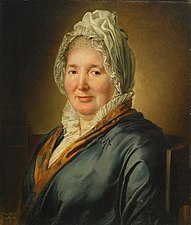Per Krafft the Younger
- Machine translation, like DeepL or Google Translate, is a useful starting point for translations, but translators must revise errors as necessary and confirm that the translation is accurate, rather than simply copy-pasting machine-translated text into the English Wikipedia.
- Do not translate text that appears unreliable or low-quality. If possible, verify the text with references provided in the foreign-language article.
- You must provide copyright attribution in the edit summary accompanying your translation by providing an interlanguage link to the source of your translation. A model attribution edit summary is
Content in this edit is translated from the existing Swedish Wikipedia article at [[:sv:Per Krafft den yngre]]; see its history for attribution. - You may also add the template
{{Translated|sv|Per Krafft den yngre}}to the talk page. - For more guidance, see Wikipedia:Translation.


Per Krafft the Younger (1 November 1777 – 12 November 1863) was a Swedish painter of portraits and historical scenes.[1]
Biography
Krafft was born in Stockholm, Sweden. He was the son of portraitist Per Krafft the Elder (1724–1793) and Maria Vilhelmina Ekebom (1749–1820) and was the brother of portrait miniaturist Wilhelmina Krafft (1778–1828). [2]
While still only a child of six, he began his studies at the Royal Swedish Academy of Fine Arts (1783–1796). He received his first medal in 1787. He studied there until 1796; notably with Lorens Pasch the Younger. At age 18, he was honored with a commission for a portrait of the powerful French politician, Francois-Emmanuel Guignard de Saint-Priest. [3]
Shortly after, under the influence of Louis Masreliez, he went to Paris, where he became a student of Neoclassical painter Jacques-Louis David.[4][5][6]
In 1801, for a major Academy exhibition in Stockholm, Krafft sent home three works: Belisarius, a smiling Cupid, and Paris as a shepherd; all composed in neoclassical style. In 1802 he traveled to Italy, where he drew cityscapes, studied the Old Masters and made copies of Raphael. In May 1803 he returned from Florence to Paris, where he became a highly sought-after portrait painter.[3]
In 1805, he returned to Stockholm, where he had received an appointment as a court painter. In 1808, he was chosen as a Deputy Professor at the Academy and, following the death of Carl Frederik von Breda in 1818, was promoted to a full Professor of Drawing; a position he held until 1856 [3]
During his career, Krafft painted more than 400 portraits, including 60 drawings, and hundreds of other works. In addition, Krafft painted about 100 paintings with biblical, historical and other motifs.[3]
Personal life
Krafft married Brita Sofia Robsahm (1784–1854). He died in 1863 in Stockholm.[3]
Gallery
-
 Portrait of the Artist's Sister Wilhelmina (1806)
Portrait of the Artist's Sister Wilhelmina (1806) -
 Portrait of Christina Hjorth
Portrait of Christina Hjorth -
 Portrait of Gustav IV Adolf of Sweden (1809)
Portrait of Gustav IV Adolf of Sweden (1809) -
 Portrait of Charles August, Crown Prince of Sweden (1809)
Portrait of Charles August, Crown Prince of Sweden (1809)
References
- ^ "Per D.Y Krafft". Lexikonett amanda. Retrieved March 1, 2019.
- ^ Boo von Malmborg. "Per Krafft". Svenskt biografiskt lexikon. Retrieved March 1, 2019.
- ^ a b c d e Boo von Malmborg. "Per Krafft". Svenskt biografiskt lexikon. Retrieved March 1, 2019.
- ^ "Get to know the artist: Per Krafft the Younger". HUMA3. Retrieved March 1, 2019.
- ^ Åke Meyerson. "Louis A Masreliez". Svenskt biografiskt lexikon. Retrieved January 1, 2019.
- ^ "Jacques-Louis David". World History of Art. Retrieved March 1, 2019.

External links
- Per Krafft the Younger - Artworks @ The Athenaeum
- More works by Krafft @ ArtNet
- v
- t
- e













